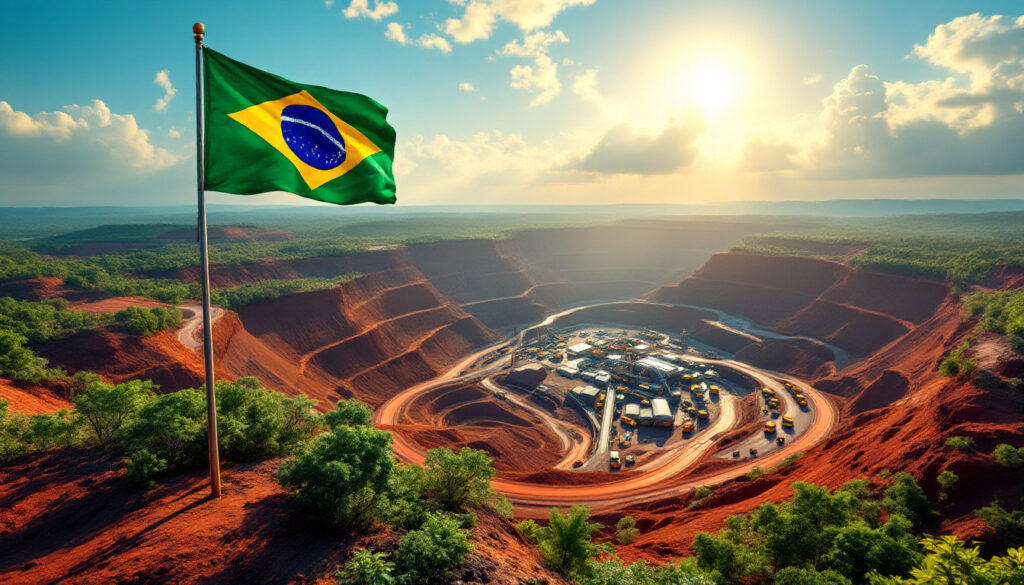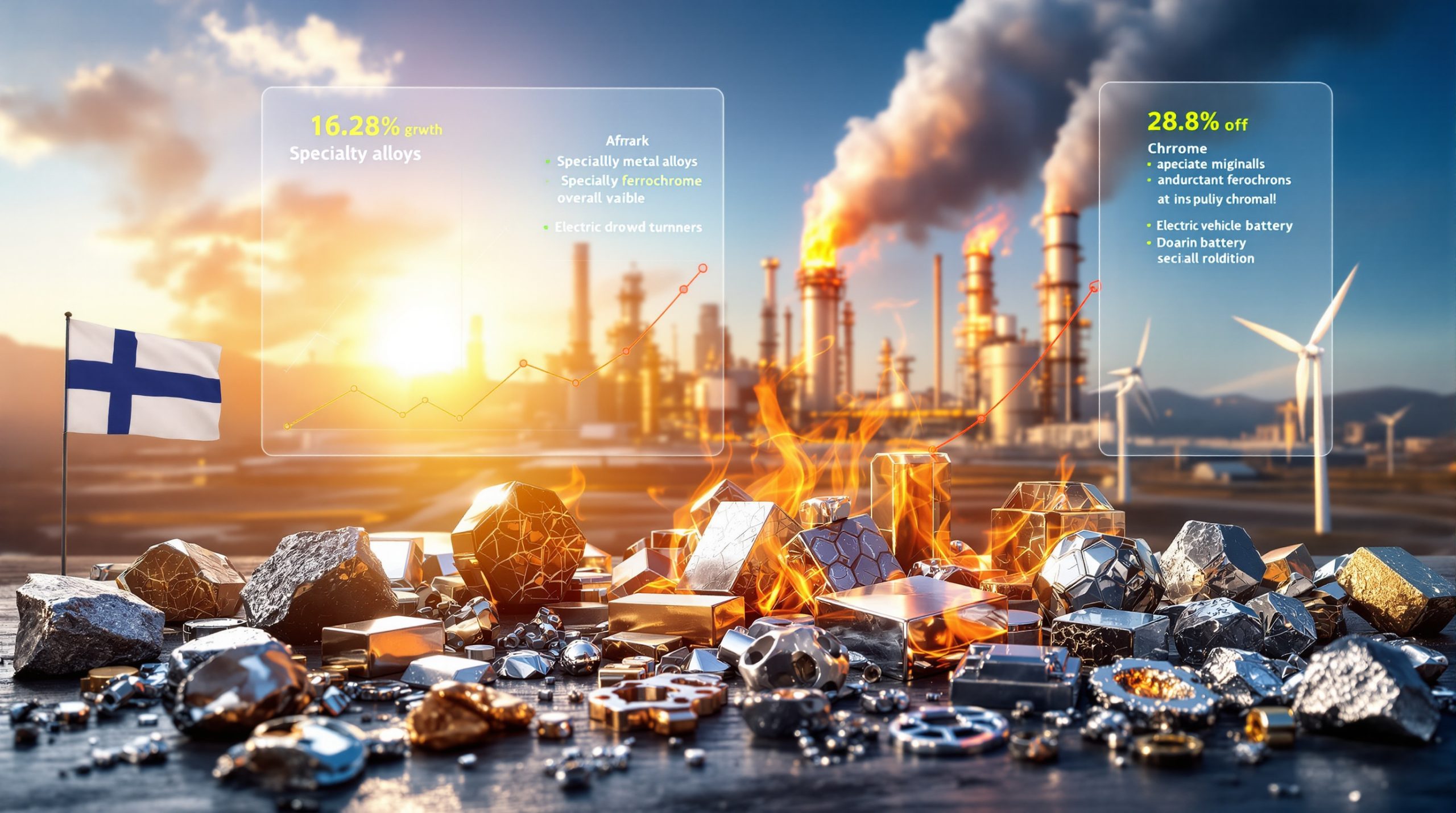Vale's Q1 2025 Financial Performance: Understanding the Impact of Lower Iron Ore Prices
Vale reported a significant drop in net income amid lower iron ore prices in Q1 2025, highlighting the challenges facing one of the world's largest mining companies. Despite implementing cost-cutting measures and strategic initiatives, the Brazilian mining giant struggled to offset the impact of commodity price fluctuations on its financial performance.
The company's financial results reflect the iron ore price volatility in the global market, with several key metrics showing notable year-on-year declines. However, Vale continues to pursue long-term growth strategies, particularly through its ambitious Carajás expansion project.
How Did Vale's Q1 2025 Financial Results Compare to Previous Year?
Vale's Q1 2025 financial performance shows a marked decline across most key metrics compared to the same period in 2024. Net income decreased by 17% to $1.39 billion (down from $1.67 billion in Q1 2024), while net operating revenues fell by 4% to $8.1 billion (46.16 billion reais) compared to $8.45 billion.
Adjusted EBITDA declined by 9% to $3.1 billion, with EBITDA margin falling to 38.3% from 42.1% in Q1 2024. This margin compression highlights the reduced pricing power Vale faces in the current market environment.
Perhaps most concerning was the dramatic 77% drop in free cash flow to $504 million (from $2.2 billion), indicating significant pressure on the company's cash-generating ability. This decline outpaced the revenue drop substantially, suggesting deeper operational challenges.
Net debt increased by 21% year-on-year to $12.19 billion, pushing the debt-to-EBITDA ratio up to 3.9x (from 3.1x in Q1 2024). This rising leverage position could potentially limit financial flexibility if market conditions worsen.
On a positive note, Vale reduced its capital expenditures by 16% to $1.17 billion, demonstrating discipline in prioritizing high-return projects like the Carajás expansion.
Key Financial Metrics and Year-on-Year Changes
- Net income decreased by 17% to $1.39 billion (down from $1.67 billion in Q1 2024)
- Net operating revenues fell by 4% to $8.1 billion (46.16 billion reais) compared to $8.45 billion
- Adjusted EBITDA declined by 9% to $3.1 billion
- Free cash flow dropped dramatically by 77% to $504 million (from $2.2 billion)
- Net debt increased by 21% year-on-year to $12.19 billion
- Capital expenditures decreased by 16% to $1.17 billion
Operational Cost Improvements
Despite revenue challenges, Vale made significant progress in reducing operational expenses. The C1 cash cost for iron ore fines decreased by 11% to $21 per tonne, representing a continued year-on-year downward trajectory in production costs.
This cost reduction is particularly noteworthy as it positions Vale as one of the lowest-cost iron ore producers globally, providing a crucial buffer against price volatility. The C1 cash cost reflects production expenses from mine to port and serves as a critical metric for operational efficiency in the mining sector.
What Factors Are Affecting Vale's Financial Performance?
The primary factor impacting Vale's financial performance is the significant decline in iron ore prices. Industry reports indicate iron ore prices fell approximately 12% year-on-year in Q1 2025, directly affecting Vale's profitability despite relatively stable production volumes.
Vale's iron ore revenue contribution dropped to 68% of total revenue (versus 72% in Q1 2024), highlighting the outsized impact of price fluctuations on the company's overall financial health.
Iron Ore Market Dynamics
China's slower steel demand growth in 2025 has been a major contributing factor to weakened iron ore prices globally. As the world's largest steel producer and iron ore consumer, China's economic patterns have an outsized impact on the commodity market.
The price-volume dynamics have been challenging for Vale, as flat production volumes (+0.5% YoY) could not offset the substantial price declines. This imbalance underscores the company's vulnerability to market pricing despite operational efficiencies.
CEO Gustavo Pimenta acknowledged these "market pricing pressures" while emphasizing the company's focus on cost management to mitigate their impact.
Strategic Initiatives and Cost Management
Vale has implemented several strategic initiatives to counter market headwinds. The company's asset review program at Vale Base Metals is beginning to yield tangible benefits, identifying non-core assets for potential divestiture.
Cost reduction strategies have shown positive results, particularly in mining operations where technological improvements and process optimization have contributed to the 11% reduction in C1 cash costs.
The company's focus on decarbonization investments, exemplified by the Aliança Energia joint venture, aims to reduce long-term operational costs while aligning with sustainability goals. This venture targets 100% renewable energy for Vale's operations by 2030, potentially creating both environmental and financial benefits.
What Are Vale's Strategic Investment Plans?
Despite financial pressures, Vale continues to invest in long-term growth initiatives, particularly through its flagship Carajás Complex expansion project.
Carajas Complex Expansion
In February 2025, Vale announced a substantial $12.26 billion investment plan focused on expanding production capacity at its Carajás Complex in northern Brazil. This strategic initiative aims to increase iron ore production to 200 million tonnes and boost copper output to 350,000 tonnes by 2030.
The investment is particularly significant given that Carajás holds approximately 7.2 billion tonnes of iron ore reserves, ensuring low-cost production scalability for decades. The high-grade ore from this region typically commands premium pricing in global markets, potentially offsetting general market price declines.
CEO Pimenta described the Carajás expansion as "essential to enhancing portfolio flexibility," highlighting its importance to Vale's long-term strategy amid market volatility.
Value-Accretive Projects
Beyond Carajás, Vale is pursuing several value-accretive projects designed to optimize its asset portfolio and improve operational flexibility. The company has emphasized "asset-light solutions" including joint ventures that reduce balance sheet risk while unlocking growth potential.
The strategic joint venture at Aliança Energia represents a key example of this approach, supporting Vale's long-term decarbonization goals while distributing capital requirements among partners with complementary expertise.
These initiatives collectively aim to position Vale for sustained profitability despite market cyclicality, leveraging the company's scale and operational expertise to maintain competitive advantage.
What Is Vale's Management Outlook?
Vale's management team, led by CEO Gustavo Pimenta, has maintained a cautiously optimistic outlook despite challenging market conditions.
Executive Perspective on Performance
Pimenta characterized Q1 2025 as "a consistent start to the year, aligned with our objectives for 2025," emphasizing the company's progress in cost management and strategic initiatives. This measured positivity suggests confidence in Vale's ability to navigate market headwinds through operational excellence.
Management has emphasized "laser-focused execution" of key strategic initiatives, particularly cost control measures and high-return capital projects. This disciplined approach reflects recognition of the challenging market environment and the need for careful resource allocation.
The company's leadership continues to emphasize long-term value creation over short-term results, pointing to investments in Carajás and other growth projects as foundations for future profitability.
Balance Sheet Optimization
Vale's management has prioritized balance sheet optimization amid rising debt levels, with liquidity reserves standing at $15.2 billion to cover short-term obligations. Pimenta specifically highlighted the company's commitment to "balance sheet optimization" alongside operational improvements.
The implementation of asset-light solutions, particularly through strategic partnerships and joint ventures, aims to reduce capital intensity while maintaining growth trajectories. This approach allows Vale to share risk and leverage partner expertise while preserving financial flexibility.
The company's alignment with long-term decarbonization goals also factors into financial planning, with initiatives like the Aliança Energia joint venture designed to reduce operational costs while advancing sustainability objectives.
How Does Vale's Performance Impact the Global Iron Ore Market?
As a contributor of approximately 20% of global seaborne iron ore supply, Vale's operational decisions and financial performance have significant implications for the broader market.
Market Position and Influence
Vale's maintained production levels despite price pressures contrast with recent output cuts by some Australian miners, demonstrating the company's commitment to supply discipline that helps prevent global oversupply situations.
The company's financial performance reflects broader market conditions, serving as a bellwether for industry trends. Vale's emphasis on cost reduction rather than production cuts suggests confidence in long-term demand fundamentals despite short-term price volatility.
The planned Carajás expansion will significantly impact global iron ore supply-demand dynamics through the latter half of this decade, potentially influencing pricing trends across the industry.
Production Cost Advantages
Vale's reduced C1 cash cost of $21 per tonne positions it as one of the most competitive iron ore producers globally, providing substantial margin cushion even during price downturns. Industry analysts note that Vale's cost leadership "offsets margin pressures" during market downturns.
This cost efficiency improvement enhances Vale's competitive position relative to higher-cost producers, potentially allowing market share gains during prolonged price weakness. The operational enhancements supporting this cost advantage appear sustainable, suggesting continued competitive strength.
Vale's focus on high-grade ore production also provides quality differentiation that typically commands price premiums, offering additional protection against market commoditization.
FAQ About Vale's Q1 2025 Performance
What caused Vale's profit decline in Q1 2025?
The 17% drop in net income was primarily attributed to lower iron ore prices (down approximately 12% year-on-year) in global markets. This price decline directly impacted Vale's revenue generation and profit margins, with EBITDA margins contracting to 38.3% from 42.1% in the previous year.
How is Vale addressing financial challenges?
Vale is implementing comprehensive cost management strategies, achieving an 11% reduction in C1 cash costs for iron ore production. The company is also optimizing its balance sheet through asset-light solutions and strategic joint ventures like Aliança Energia. Additionally, Vale is investing in value-accretive projects such as the Carajás expansion to enhance portfolio flexibility and operational efficiency for long-term profitability.
What are Vale's major investment plans for the future?
Vale plans to invest $12.26 billion in its Carajás complex to expand iron ore production to 200 million tonnes and increase copper production to 350,000 tonnes by 2030. This flagship project leverages Carajás' 7.2 billion tonnes of high-grade iron ore reserves to ensure sustainable growth. The company is also pursuing strategic joint ventures in base metals and energy sectors to share capital requirements while accessing complementary expertise.
How has Vale's debt position changed?
Vale's net debt increased by 21% year-on-year to $12.19 billion as of March 31, 2025, indicating higher leverage compared to the previous year. This increase pushed the debt-to-EBITDA ratio to 3.9x (from 3.1x), reflecting both lower cash flows and strategic investments. The company maintains liquidity reserves of $15.2 billion to cover short-term obligations while pursuing balance sheet optimization strategies.
For investors considering investing in mining stocks, Vale's current situation highlights the importance of understanding how commodity price cycles affect company performance. Furthermore, mining feasibility studies like those conducted for the Carajás expansion provide critical insights into a project's potential return on investment.
According to global commodities insights, Vale's situation reflects broader market trends affecting major iron ore producers. Industry analysts at Reuters have noted that Vale's production discipline is particularly important for market stability during price downturns. Additionally, Mining.com reports that implementing effective mining investment strategies remains crucial for companies navigating commodity price volatility.
Disclaimer: This article contains analysis and speculation regarding Vale's future performance and market conditions. Readers should conduct their own research and consult financial advisors before making investment decisions based on this information.
Want to Identify the Next Major Mineral Discovery Before the Market?
Stay ahead of the crowd with Discovery Alert's proprietary Discovery IQ model that instantly identifies significant ASX mineral discoveries as they happen, turning complex geological data into actionable investment insights. Explore our dedicated discoveries page to understand why major mineral discoveries often lead to exceptional market returns.




